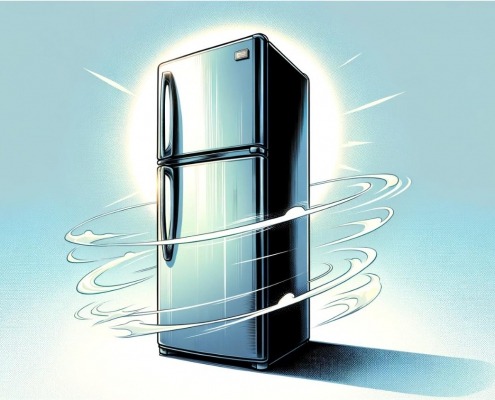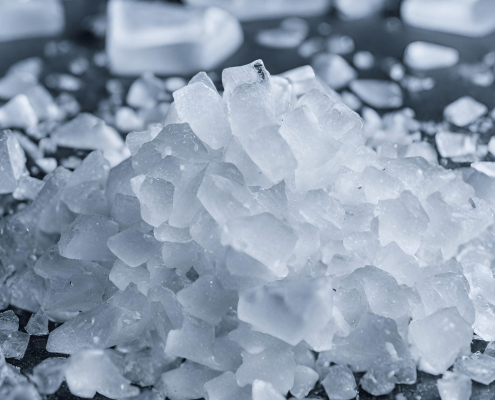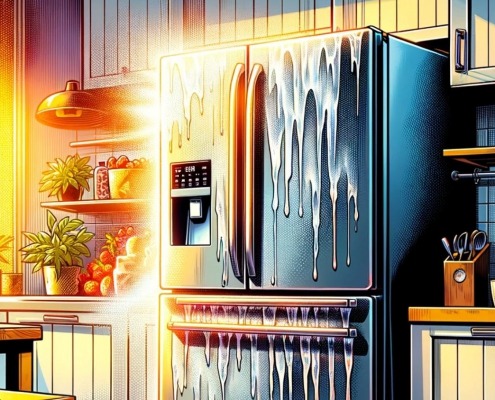Freezer Section Too Warm: Top 6 Reasons and Fixes for Kenmore, Whirlpool, Frigidaire, GE, and Other Brands (With Video!)
APP Expert / Thursday September 2, 2021
Is your freezer losing its chill and running warmer than it should? A malfunctioning freezer can ruin your food and your day, but don’t worry—there’s a quick solution! Dive into our step-by-step troubleshooting guide to identify and fix the problem yourself, and be sure to check out our how-to video just below for expert guidance.
Six components are commonly associated with freezers that malfunction and become too warm. Freezers that are operating above safe temperatures for frozen foods can easily lead to food safety issues so it is important to diagnose and fix this problem quickly. Before you start checking this part for a malfunction, make sure the circuit breaker for the area is off or the appliance is unplugged. The water supply for the refrigerator, found under the sink, should also be turned off. Once your refrigerator is safe to work with, follow this troubleshooting guide to determine which refrigerator parts are to blame and save money fixing your freezer yourself.
Once you have identified the part needed for your freezer, search below using your specific refrigerator model number to identify the exact part needed:
1. Condenser Coils
Condenser coils are responsible for condensing and cooling the refrigerator, including the freezer area. That’s why it’s essential to ensure the coils are clean and not covered in dirt, dust, and other debris. This kind of debris can insulate the coils and make it impossible for the freezer to stay as cold as you would like.
The coils can be found on the back of the unit behind the access panel. You will need to remove the panel before cleaning the condenser and other components in this area. The cleaning can be done with a clean cloth or you can get better results using a refrigerator coil brush.
2. Defrost Timer
The defrost timer is made of a motor, contacts, and gears and is responsible for controlling the defrost cycle of the refrigerator. It moves the fridge between the defrost and cooling periods and prevents the evaporator from becoming covered in ice buildup. The timer has a set number of minutes for defrosting and hours for cooling, which is typically listed on the defrost timer itself.
In most cases, you’ll find the defrost timer in the control section of your refrigerator. If you own an older refrigerator, it may be located behind the kick panel at the bottom of the fridge. Sometimes your freezer may become too warm if the defrost timer is no longer working. This causes the evaporator to freeze up, which means that cold air won’t circulate throughout the appliance.
When checking whether the defrost timer is moving, you can mark the shaft of the timer and come back to it later to see if it’s in the same position. If it hasn’t moved, the gears or motor have failed, and you will need to replace the defrost timer.
Another option is to use a screwdriver to move the shaft manually. Once you hit defrost mode, the heater should come on. This will require plugging the refrigerator back on to see whether it’s working. This needs to be done when the freezer is cold or the thermostat won’t allow the heater to start up. Access the heater behind the back wall of the freezer. After one or two minutes, heat should be felt. If this isn’t the case, move on to the next step to see if one of the other issues is present.
3. Cold Control
The freezer temperature is set using the cold control, which includes a sensor bulb to determine the temperature, a shaft where the knob is located, and a body that has contacts inside. In most cases, these also will have two wire terminals inside of them. You’ll typically find these on the control panel that is mounted behind the control knobs for your refrigerator.
If the freezer is running warm, the cold control may have gone bad. The sensor creates pressure that opens and closes the contact for the cold control sensor bulb. When temperature changes in the freezer, the liquid in the bulb will contract or expand. If the compressor isn’t coming on as expected and the freezer is becoming warm, the inside contact may have become stuck.
There’s an easy test you can do while the refrigerator is running. Knock on the area around the knob with a tool like the base of a screwdriver or a hammer, which may result in breaking the contacts free. If this works and your freezer begins to get cold again, this may indicate that the contacts are sticking together. This means it’s time to replace the cold control.
If the test didn’t work, the first thing you should do is unplug the refrigerator before you move on to other work. A multimeter can be used to see if the component is carrying electric current. It should be set to continuity before you press the probes together to be sure it’s working correctly.
To test the cold control, you’ll need to open the control section, remove the wires, and place the cold control to the off position. Touch the probes to each terminal, which should not have continuity. Next, turn the cold control on and repeat the process. It should have continuity, and if it does not, it should be replaced. You should also check the sensor bulb for damage or leakage, which is another indication of a replacement.
4. Temperature Sensor
The temperature sensor is responsible for letting the control board know how hot or cold it is inside of your freezer. The sensors are going to be white plastic bulbs that tell the control bulb the temperature so the compressor runs when it should. These sensors are often in several areas of the refrigerator, such as inside an air duct, behind the back wall, or behind the access panel.
Another reason your freezer might be too warm is that the temperature sensor isn’t working. Testing the sensor requires removing it from the system by unplugging it. It can typically be left in the refrigerator while you go through the testing process. Check the ambient air temperature using a thermometer. Each sensor will have a different ohm reading based on the temperature, so you will need to check your text sheet.
Make sure your meter is set to ohms and then place the probes on the wiring harness pins or the bare wires to see what the ohms reading is. It should be similar to the number listed on your text sheet. If it isn’t showing a reading or the reading isn’t where it should be, it is time to replace the temperature sensor.
5. Defrost Thermostat
The defrost thermostat is a safety component that turns off the defrost cycle when the freezer is too warm. If the temperature gets too hot, the thermostat turns off power to prevent melting your frozen products. Most have a temperature rating listed on them, so you know at what temperature the defrost cycle will be turned off.
In most cases, you’ll find the defrost thermostat behind the back wall of the freezer on the evaporator. If the freezer is too warm, the thermostat may no longer be working. The evaporator can freeze up so cold air isn’t circulated. Testing this involves determining whether the thermostat is colder than the reset temperature. Testing in the freezer is a good option since it should be around zero degrees Fahrenheit.
Make sure your meter is set to continuity and touch a probe to each terminal or bare wire. The probe should be touched to each and should have continuity when it’s cold. If this isn’t the case, the component has failed and needs to be replaced.
6. Defrost Heater
The defrost heater is the last component to look at when your freezer is too warm. It heats up to melt any buildup of ice present on the evaporator. Defrost heaters come in many different shapes and styles but all heat up during defrost to melt ice and ensure the refrigerator cools as it should.
In many cases, this will be found behind the wall in the freezer on the sides and bottom of the evaporator. A failure of this part may lead to a freezer that is too warm. Cold air will not be able to circulate normally, so a continuity test is required. This is done by removing the wires and touching each end to a test probe. If there is no continuity, the part is bad and should be replaced.
Where To Find Us
If you need any replacement parts for your appliances, you can enter your model number at AppliancePartsPros.com to locate and order them quickly. Most orders arrive in just two business days, and we have tons of great information in our repair help section and YouTube videos to help you troubleshoot.
Stay connected with the latest DIY tips, tutorial videos, and repair guides by following us on Facebook, Instagram, and Twitter. We love hearing about your repair stories and successes. If you need more help or want personalized guidance, feel free to contact or call us at 877-477-7278. We’re ready to help you take on your next project with confidence!
Since 1999, AppliancePartsPros.com has helped millions of people repair their broken appliances by providing high-quality original parts at well below retail prices, free support and troubleshooting, and award-winning customer service from an expert, friendly, US-based customer support team!
Hi! I’m Matt H., and I’m thrilled to be your guide through the world of appliance repair with over 25 years of invaluable experience in the industry.
From the early days of my career, I have been deeply passionate about appliances and their inner workings. Over the years, I’ve seen it all – from vintage models to the latest cutting-edge technology – and I’ve dedicated myself to mastering the art of repair. With a toolbox in one hand and a wealth of knowledge in the other, I’ve tackled every challenge that has come my way, learning and growing with each repair.
Join me as we dive into the intricacies of appliance repair. From step-by-step repair guides to explanations of common problems and their solutions, I’ll be here to simplify the repair process and empower you with the knowledge you need to keep your appliances running smoothly.
Feel free to explore our blog, ask questions, and leave comments – this platform is a space for learning, sharing, and growing together. Let’s work together to ensure that your appliances continue to serve you for years to come.
Thank you for joining me on this journey, and I look forward to being your go-to resource for all things related to appliance repair!





